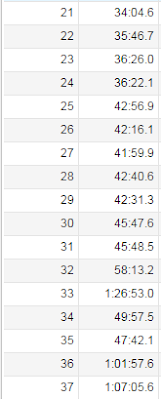I was in a walking boot for two weeks. By early July I was starting to go on progressively longer walks for exercise working up to 20 miles by the end of the month, but running was still resulting in pain in my calf. I had already registered for the 100k at the Marquette 50 trail race in mid-August and it was obvious at this point that attempting the race would not be a good idea for my long term goals this year so I recorded my second DNS. This brought my total to 15 ultra registrations resulting in 13 finishes and 2 DNS.
My training since mid-August went very well at a slower pace so I registered for two races this fall/winter. First was the St.Pat's 24 Hour Race in South Bend, Indiana. I was surprised at how well 5 hour training walks (around 14:00 pace) translated to being able to increase my long run mileage much faster than normal. My last five long runs going into the race were 35, 40, 40, 31, and 40 miles around 9:00 pace and they felt pretty good. I was doing minimal running between my long runs since I did not seem to be recovering from those long runs quite as quickly. I knew I was not in as good of shape as I was last year, but good enough to get a race in this year.
 |
| In 2014 I had a nice and steady build up to my 24 hour race. |
 |
| In 2015 I had to reset after my injury in May and had limited training mileage. |
There was one area where I did more training than previous years, and that was my nutrition. I have flirted with a lower carb diet in the past, but this year I was much more serious about it. I ate a low carb high fat diet where I kept between 30-50 grams of total carb most days. In the last 2 weeks that dropped to about 10 grams of carb per day. My diet was made up of mostly vegetables, meat, cheese, eggs, and salad dressing. My carbs came from vegetables and beer that I did not give up until the final 2 weeks. I had trained my body to be a much more efficient fat burner in hopes that I could drop my in-race calories to prevent stomach issues. I did still eat my sugary foods on my one long training run per week at the rate of 75 calories per 5 km which was my goal for my race.
The St. Pats 24 hour run is set in South Bend, IN at a county park where we did a 5k loop on trails as many times as possible in the allowed time. It was a relatively cold weekend where the temperature would not reach 50 degrees during the day and the race website posted afterwards that the temperature reached 24 degrees at night. At the start my 5k loops were landing in the 27 minute range which was a little quick, but I knew I had time to settle into my pace closer to 30 minutes per 5k. There was nothing to note through the first 100k (62 miles, 20 laps). Everything to that point was on point. Every lap I had eaten half of a nutty bar. Every fourth lap I drank 2.5 oz of VegaSport Energizer drink while I drank 2.5 oz of VegaSport Hydrator the other laps. These are sports drinks without sugar that I have grown to enjoy since I like having the flexibility to keep up my hydration and electrolytes independent of sugar intake.
This is the point of the race where I started to feel the lower training volume start to impact my race. My laps slowed down quickly and by 100 miles I slowed to a crawl and got cold quickly since I was still just wearing a very thin jacket. I took some time to warm by the fire, got some warmer clothes on, and walked most of the last 20k.
I added some short laps at the end to finish with a total of 115.7 miles. I finished second overall to Shan who completed 124 miles. Overall I was happy with my race. I knew I was slightly under-trained compared to last year, but I was very happy with my nutrition in this race. I consumed a total of 2287 calories during the race which is less than many folk eat on a normal day. I think less is better in terms of keeping my stomach happy when running. I consumed 4023 calories in my 24 hour race last year. Running primarily on fat seemed to keep my stomach in a much happier place. I am curious to see if my legs were in better shape if I could have maintained my pace on the lower calorie intake. Here is the breakdown of my calories:
During the late stages of the race my plantar fasciitis, that had been worse this year than normal, really flared up. My feet were pretty torn up for a couple of weeks. After a couple of weeks I needed to get training again for the winter race that I referenced. I was signed up for the Tuscobia 80 mile race in northern Wisconsin in January. I will make another post with that story.


